USWE Pace 8
Test Location: Logan, Utah & Lake City, Colorado
Test Duration: ~300 miles
Stated Storage Volume: 8 L / 488 cu in
Reviewer: 6’1”, 145 lbs / 185 cm, 67 kg
Size Tested: Men’s M-L
Stated Weight (Pack only): 258 g / 9.1 oz
Blister Measured Weight (Men’s size M-L):
- Pack: 268 g
- Soft Flasks: 79 g
- Total: 347 g
MSRP: $159.95
- Polygiene Stays Fresh treatment. Keeps the vest fresh and permanent odour free.
- Bounce free No Dancing Monkey™ Vest system and elastic side panels that expands along with the chest during physical exertion, allowing a constant tight and compliant fit.
- 2x 500ml Ultraflasks in a 45” angle front pockets for outstanding comfort.
- Inner No Bounce Compression Compartment with pull-tight straps accessible at the front for a hydration bladder. Bladder not included.
- Front pole attachment
- 2x Quick stash front pockets
- 2x Energy/food shoulder pockets
- 2x zippered stash back pockets
- High-ventilated mesh back panel
- Reflective points for night visibility
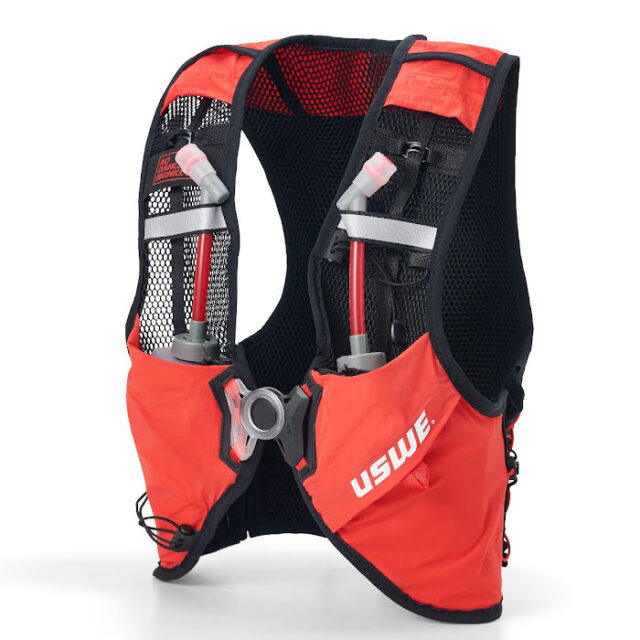
Intro
For years, I’ve been on the hunt for a running vest that works as well as my somewhat outdated Salomon AdvancedSkin 5 Set from 2015 — mostly without much luck. So with that in mind, I was both curious and a bit skeptical about the USWE Pace 8. USWE is a Swedish company that got their start making dirt biking and mountain biking packs, so they’re not exactly a household name in the running world. Still, their primary goal of making “Bounce-Free Action Backpacks” makes just as much sense (if not more) for running as it does for mountain biking. Given all that, I was curious to see how USWE’s running packs would stack up to packs from more established running brands like Ultimate Direction, Nathan, and yes, Salomon.
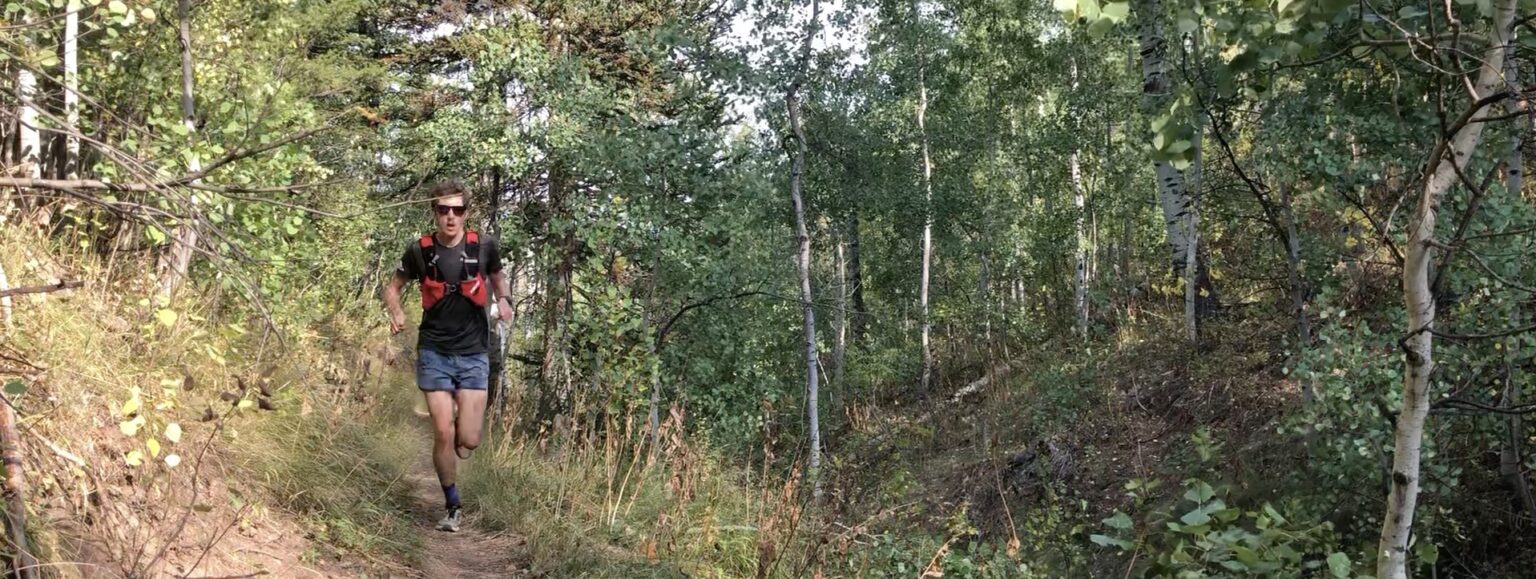
To that end, I’ve been testing the Pace 8, which is USWE’s higher-capacity race-oriented vest. True to the brand’s mountain / dirt biking heritige, the Pace 8 has a unique X-shaped suspension system that’s definitely a bit of a departure from the usual sternum strap setup found on most other running vests (that X-shaped design also happens to have the most interesting name of any running vest technology I’ve encountered: “No Dancing Monkey”). I wasn’t sure what to expect out of the Pace 8 — after all, why would brands like Salomon, Ultimate Direction, and Nathan all still be using traditional sternum straps if USWE’s system worked better?
After a few months of testing, I’m happy to report that — at least in the case of the Pace 8 — going against the status quo can yield some pretty great results. I’ve been very impressed by the pack’s overall performance, especially considering it’s one of USWE’s first stabs at a running-specific pack. Still, though, the Pace 8 does have its quirks. In this review, I’ll break down how the Pace 8 compares to the competition, what makes it such a solid pack, and where it’s got some room for improvement.
Fit
As always, it’s best to try on the Pace 8 if you’re able — especially since Sweden-based USWE’s sizes are a little different from pack size ranges from US-based companies. I usually wear a Men’s Small or Extra-Small in running vests from Ultimate Direction, Salomon, and Nathan (and sometimes that’s even too big), but for the Pace 8, a size M-L fits me perfectly. For reference, I’m 6’1” and ~150 lbs with a fairly narrow chest. So again, if possible, try on the Pace 8 in person before you buy. If you do have to order online, I’d recommend going up a size from whatever you usually get in packs from other brands.

Aside from the sizing differences, I think the Pace 8 fits extremely well. As I mentioned in the Intro, the Pace 8 uses USWE’s “No Dancing Monkey” suspension system, which, aside from sounding slightly ridiculous, consists of one central sternum buckle and a set of elastic side adjustment cords. Unlike most packs from other running brands, the Pace 8’s adjustability is all on the sides of the pack, rather than across the front of the chest. Instead of adjustable sternum straps, the Pace 8 has a single fixed buckle, which secures the two shoulder straps in an X-shape. Each side of the pack has an adjustable zig-zagged elastic cord that attaches the bottom of the chest strap to the back of the pack (similar to the Ultimate Direction Race Vest 5.0), which lets you loosen or tighten the pack’s fit. There’s also a set of straps that run from the inside of the back of the pack to the top of each shoulder strap that allows for a little bit of adjustability in how tightly the tops of the shoulder straps fit.
I was a little concerned that the lack of adjustability across the front of the Pace 8 would make it harder to get a secure fit, but I’ve been duly impressed by the Pace 8’s fit so far. Between the elastic side straps and the straps across the tops of the shoulder straps, I’m able to get a secure fit with both large and small loads. As promised, there’s very little bounce — even with heavy / bulky loads.
The Pace 8 is also super comfortable. The stretchy material on the sides of the pack allows the pack to expand and stretch with your breathing, eliminating the constricting feel that I’ve gotten from packs like the Ultimate Direction Race Vest 5.0. I also haven’t had any issues with chafing, rubbing, or breathability in the Pace 8. At least from a fit perspective, the Pace 8 gets full marks in my book.
Features and Construction
Aside from the Pace 8’s unique suspension system, the pack itself is fairly simple. Each shoulder strap has two large pockets: a big, stretchy diagonal pocket that fits a 500 mL soft flask, and an outer stretchy pocket that easily fits an iPhone 8 in a LifeProof case (or lots of snacks). There’s also a safety whistle attached to the top of the right-hand soft flask pocket. Aside from those main pockets, the chest straps have a set of elastic loops that can be used to diagonally store folding trekking poles across the front of the pack. Lastly, there’s a set of downward-facing pockets for storing gels at the top of each shoulder strap — which seemed like a bad idea to me until I tried them out (more on that later). The shoulder adjustment straps I mentioned earlier also come out of these pockets.
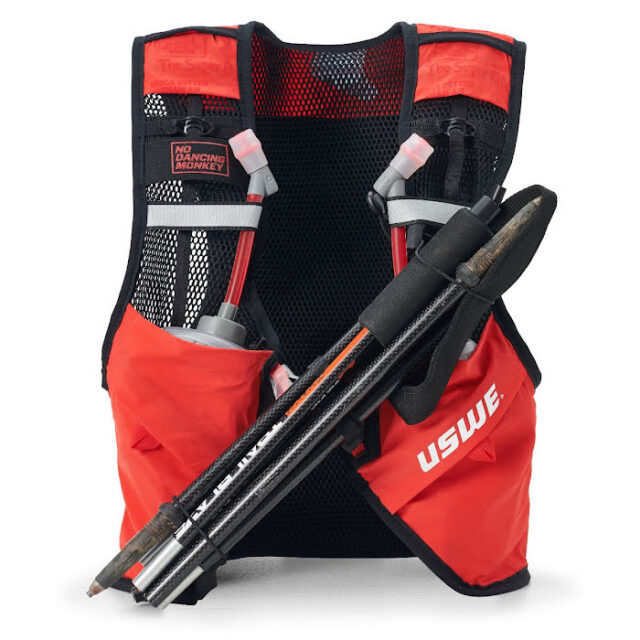
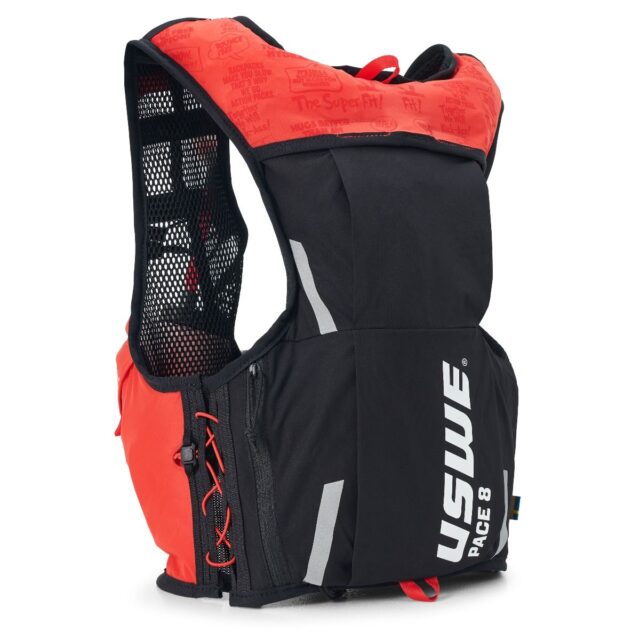
Moving around to the back of the pack, the Pace 8 has four main pockets. The first is a large, stretchy, vertical pocket that runs the entire length of the pack and can eat up extra layers, extra food, and so on. Inside that main compartment is a sleeve for a 2-liter bladder (not included). The top of the bladder sleeve actually attaches to the straps that run across the tops of the shoulders, which supposedly helps cinch down the bladder to prevent bouncing. The Pace 8 also has two pockets that run across the bottom of the pack. The first is a horizontal kangaroo-style pocket with a zipper closure that’s functionally pretty similar to the kangaroo pockets on packs like the Nathan VaporKrar 2.0 12 L and Salomon Advanced Skin 5 Set. The second is a little less common — it sits under the kangaroo pocket and is accessed through a zipper that runs horizontally across the bottom of the pack. Much like the downward-facing gel pockets on the shoulder straps, this pocket seemed like kind of a bad idea until I tried it out on the trail. I’ll go more in-depth on that later, but suffice to say that it works a whole lot better than you might expect.
Weight
I’m usually not overly concerned with weight when it comes to race vests — as long as the pack fits and functions well, I don’t mind a few extra grams here and there. Still, the Pace 8 is pretty much in the back of the pack (if you’ll excuse the pun) when it comes to weight. For reference, here’s how the Pace 8’s stated weight compares to running vests from other brands (all weights are for pack only, not including bladders / soft flasks):
122 g / 4.3 oz — The North Face Flight Race Day Vest (8 L)
141 g / 5.0 oz — Ultimate Direction Race Vest 5.0 (8.5 L)
141 g / 5.0 oz — Nathan Pinnacle 4L (4 L)
200 g / 7.0 oz — Patagonia Slope Runner Pack (8L)
228 g / 8.0 oz — Salomon Advanced Skin 5 Set (5 L)
235 g / 8.3 oz — Nathan VaporAir 7L (7L)
258 g / 9.1 oz — USWE Pace 8 (8 L)
So yeah, the Pace 8 is pretty heavy by race vest standards. It also doesn’t fare too well from a weight-to-volume ratio perspective — packs like the Ultimate Direction Race Vest 5.0 offer about the same amount of storage in a much lighter package. With all that said, I still like the Pace 8 better than almost all of the other packs on that list that I’ve tested (spoiler alert). I stand by what I said at the beginning of this section — if a pack fits well and performs well, I think extra weight is much less noticeable than it might be in a shoe. For my preferences, the Pace 8 fits and performs better than the majority of the lighter packs on this list, and I honestly don’t notice the extra weight out on the trail (which is probably in part due to its snug, bounce-free fit). Still, if you’re concerned with keeping your race kit weight to an absolute minimum, you might need to look elsewhere.
On The Trail
To be clear right out of the gate, the Pace 8 has quickly become one of my favorite running packs over the last couple of months. I’ve used the pack for everything from fairly mellow 2-hour training runs to a mountainous 50-mile race that lasted almost 8 hours. Over the course of all those runs, I’ve also tested the Pace 8 with a variety of load sizes and in a variety of weather conditions. And over the course of all those runs, I’ve been very impressed by the Pace 8’s overall performance. It isn’t perfect, but it does pretty much nail my two main criteria: secure fit and functional pocket placement.
I’ve already mentioned that I really like the way the Pace 8 fits, but I think it’s worth re-emphasizing the fact that I’m able to get a secure and comfortable fit in the pack pretty much regardless of what’s in it. In packs like the Nathan Pinnacle 12L and VaporKrar 2.0 series, I’ve only been able to get a secure, bounce-free fit when the pack is fairly full and balanced front-to-back when it comes to the weight of the contents. In the Pace 8, I can get the pack to fit well whether it’s fully loaded or just has a pair of soft flasks up front and nothing in the back. No Dancing Monkey indeed. In my book, that alone makes the Pace 8 a pretty compelling option for a race-day pack. In a race setting, I’m constantly changing the weight distribution in my pack as I drink water, eat food, and put on / take off layers — so it gets old pretty quickly if my pack starts bouncing around a whole bunch every time I take out my raincoat. I’ve definitely had that issue with some other packs I’ve recently tested, but the Pace 8 stays put regardless of load size.
I also give the Pace 8 high marks for innovative and functional pocket placement. The large front pockets make it easy to stash larger items (e.g., a phone), and there’s plenty of space between the two shoulder straps to store enough calories for multiple hours of running. The downward-facing gel pockets at the top of each shoulder strap also work impressively well; initially, I figured whatever I put in them would just fall out as soon as I started running, but they’re actually surprisingly secure and convenient to use while running.
But what really sets the Pace 8 apart from the competition in my book is how easy it is to access the pack’s rear storage. You’ve probably picked up on the fact that I’m a big fan of kangaroo pockets by now, so it’s no surprise that I really like the horizontal, zippered kangaroo pocket across the bottom of the Pace 8 — it’s easy to reach without taking off the pack, and it’s big enough for a compact jacket. Since the pocket has a zipper, it’s also a convenient place to store smaller items (e.g., gloves, hats, extra food, headlamp, etc.) that might bounce out of an open-ended kangaroo pocket like the one on the Salomon Advanced Skin 5 Set.
As I mentioned in the Features & Construction section, I was pretty skeptical about the Pace 8’s other rear zipper pocket — the horizontal zipper access across the bottom of the pack seemed like it’d just let everything in the pocket fall out as soon as you opened it. But once again, my initial reservations were unfounded. The pocket sits tightly enough against your back that it’s actually surprisingly secure — I’ve even stashed a headlamp in there and forgotten to close the zipper, and it stayed put for the remainder of my run.
Between those two zipper pockets, the Pace 8 has more rear storage that I can access without removing the pack than any other running vest I’ve used. It’s still fairly hard (though not impossible, depending on how flexible you are) to access the large rear vertical pocket, but I can almost always fit everything I’ll need in the two zipper pockets or on the front of the vest. Combine that with the Pace 8’s comfortable, bounce-free fit, and you have a pretty awesome pack (at least in my opinion).
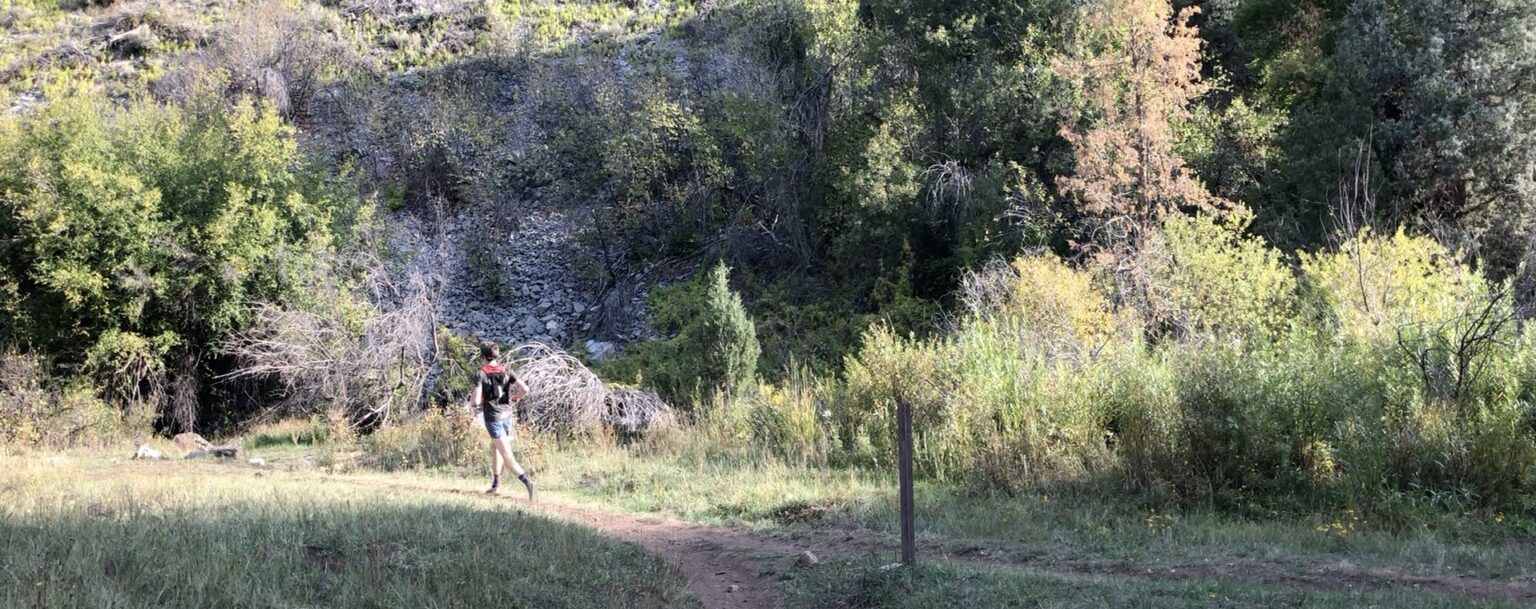
Still, I think the Pace 8 does have some room for improvement — mostly on the front of the pack. First off, the diagonal trekking pole storage system is pretty awkward — the poles sit on top of all the other pockets, which makes it annoyingly hard to access whatever you have stored in the two large stretchy pockets on the front of the vest. It is easy to attach and detach the poles, which I like, but I’d prefer a system that didn’t block off so much storage. Second, I think the Pace 8 would benefit from a few smaller pockets on the front of the pack. I like the large stretchy pockets, but I often have smaller items that I also want easily accessible (e.g., chapstick, salt tabs, keys, etc.). If I put those kinds of things in the large stretchy pockets, they can be pretty hard to keep track of. Given that, it’d be pretty nice to have an additional small pocket or two on each strap to keep those easily misplaced items separate. Finally, while I think the X-shaped suspension system works very well overall, the single buckle does create a little bit of a pressure point — especially since it’s made of hard plastic. A little extra padding and / or some more forgiving materials could give the pack a slightly more comfortable fit.
Still, in the grand scheme of things, those are all pretty minor issues — and they might not be issues for you at all, depending on your fit and storage preferences. Overall, I think the Pace 8 comes closer to my gold standard (the Salomon Advanced Skin 5 Set) than any other pack I’ve reviewed. Both packs are extremely comfortable, don’t bounce around, and have easily accessible storage. If you prefer having a separate little pocket for everything, the Advanced Skin 5 Set probably still takes the cake. But I think the Pace 8 has more functional storage on the back of the pack, thanks to the two zippered pockets. In my opinion, all of those features taken together make the Pace 8 a pretty ideal racing and training pack in my book.
Durability
I’ve run about 300 miles in the Pace 8 over the last couple of months, and I’ve been happy with the pack’s durability so far. Of course, my old Salomon pack probably has close to 1000 miles on it and is still going (mostly) strong, so I’ll have to spend a whole lot more time in the Pace 8 before I can be confident in its long-term durability — but so far, so good. I haven’t noticed any fraying or unusual wear, and the pack’s materials have held up to numerous bushwhacks without sustaining any rips. If I run into unexpected problems later on I’ll be back with updates, but at the moment it definitely seems like the Pace 8 will hold up for several hundred more miles.
Who’s It For?
I think the Pace 8 is a solid option for anyone looking for a training or racing vest, as long as absolute minimum weight isn’t your top priority. Packs like the Nathan Pinnacle 12 L or Salomon Advanced Skin 5 Set have a wider variety of storage options thanks to their numerous small pockets, but if you don’t mind most of your gear being in a few larger pockets, I think the Pace 8 has more easily accessible storage overall. I’ve already said that I think the Pace 8 would make a great racing pack, but I also think it’d be a solid option if you’re looking for a pack that can handle the abuse of day-to-day use — it feels much sturdier than lighter packs like the Ultimate Direction Race Vest 5.0. So whether you’re looking for your next race vest or just a functional, comfortable training pack, I definitely think the Pace 8 is worth checking out.

Bottom Line
I’ve been way more impressed by the USWE Pace 8 than I ever would’ve expected for a pack from a historically biking-oriented brand — so much so that it has finally ended my years-long search for a pack to replace my disintegrating Salomon Advanced Skin 5 Set. The Pace 8 is comfortable, secure, and has an abundance of easily accessible storage options. Sure, there are a few minor tweaks that could make it even better, but I think it’s well worth trying out as-is if you’re considering upgrading your running vest.




HI
I have the pace 8 which I love but on one side as soon as my water flask gets half way and it becomes more squishy it’s falling out of the pocket,do you no of anyway I could stop this from happening I’m due to run my first marathon in a week any suggestions would be gratefully received
I know this response is 2 years too late but better late than never.
I blow air back into my flask, so it keeps its rigidity and does not get floppy.
hope this helps someone else who has this issue.